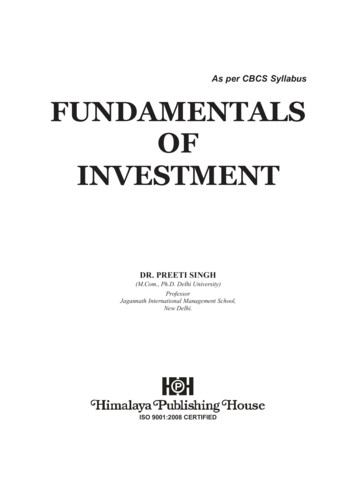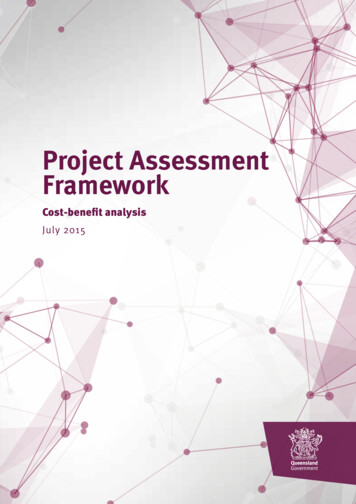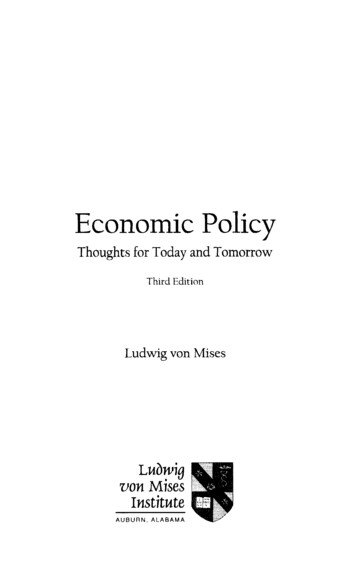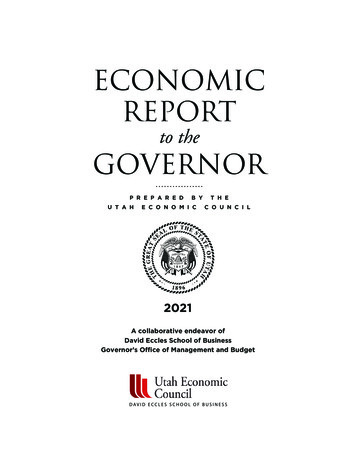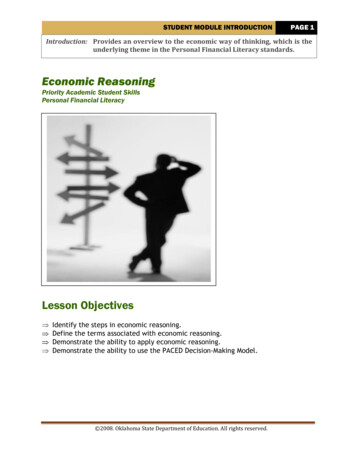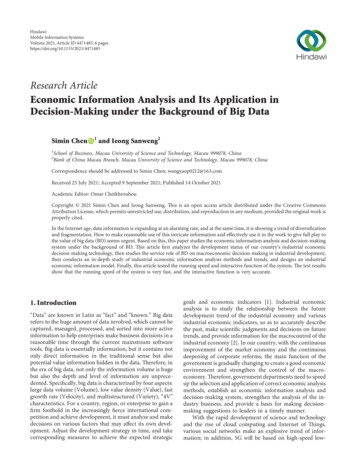
Transcription
HindawiMobile Information SystemsVolume 2021, Article ID 4471485, 6 pageshttps://doi.org/10.1155/2021/4471485Research ArticleEconomic Information Analysis and Its Application inDecision-Making under the Background of Big DataSimin Chen121and Ieong Sanweng2School of Business, Macau University of Science and Technology, Macau 999078, ChinaBank of China Macau Branch, Macau University of Science and Technology, Macau 999078, ChinaCorrespondence should be addressed to Simin Chen; wangyaop0212@163.comReceived 25 July 2021; Accepted 9 September 2021; Published 14 October 2021Academic Editor: Omar CheikhrouhouCopyright 2021 Simin Chen and Ieong Sanweng. This is an open access article distributed under the Creative CommonsAttribution License, which permits unrestricted use, distribution, and reproduction in any medium, provided the original work isproperly cited.In the Internet age, data information is expanding at an alarming rate, and at the same time, it is showing a trend of diversificationand fragmentation. How to make reasonable use of this intricate information and effectively use it in the work to give full play tothe value of big data (BD) seems urgent. Based on this, this paper studies the economic information analysis and decision-makingsystem under the background of BD. This article first analyzes the development status of our country’s industrial economicdecision-making technology, then studies the service role of BD on macroeconomic decision-making in industrial development,then conducts an in-depth study of industrial economic information analysis methods and trends, and designs an industrialeconomic information model. Finally, this article tested the running speed and interactive function of the system. The test resultsshow that the running speed of the system is very fast, and the interactive function is very accurate.1. Introduction“Data” are known in Latin as “fact” and “known.” Big datarefers to the huge amount of data involved, which cannot becaptured, managed, processed, and sorted into more activeinformation to help enterprises make business decisions in areasonable time through the current mainstream softwaretools. Big data is essentially information, but it contains notonly direct information in the traditional sense but alsopotential value information hidden in the data. Therefore, inthe era of big data, not only the information volume is hugebut also the depth and level of information are unprecedented. Specifically, big data is characterized by four aspects:large data volume (Volume), low value density (Value), fastgrowth rate (Velocity), and multistructured (Variety), “4V”characteristics. For a country, region, or enterprise to gain afirm foothold in the increasingly fierce international competition and achieve development, it must analyze and makedecisions on various factors that may affect its own development. Adjust the development strategy in time, and takecorresponding measures to achieve the expected strategicgoals and economic indicators [1]. Industrial economicanalysis is to study the relationship between the futuredevelopment trend of the industrial economy and variousindustrial economic indicators, so as to accurately describethe past, make scientific judgments and decisions on futuretrends, and provide information for the macrocontrol of theindustrial economy [2]. In our country, with the continuousimprovement of the market economy and the continuousdeepening of corporate reforms, the main function of thegovernment is gradually changing to create a good economicenvironment and strengthen the control of the macroeconomy. Therefore, government departments need to speedup the selection and application of correct economic analysismethods, establish an economic information analysis anddecision-making system, strengthen the analysis of the industry business, and provide a basis for making decisionmaking suggestions to leaders in a timely manner.With the rapid development of science and technologyand the rise of cloud computing and Internet of Things,various social networks make an explosive trend of information; in addition, 5G will be based on high-speed low-
2delay internet cloud service technology revolution, and itwill greatly improve user service quality and bring morepossibilities to the cloud service; the internet will flood intomore levels of people and promote the data types andcategory of the whole society; the arrival of the big data eramakes information communication more convenient, whichwill cause a new round of information technologyrevolution.Chinese scholar Wang pointed out that, in terms ofindustrial economic information analysis, it is necessary toadapt to the development of the times and use relevant dataanalysis methods to integrate information processing solutions that are compatible with industrial development toensure that the industry can develop steadily. From thedevelopment process of big data, not only China attachesgreat importance to big data but also the whole world realizes the huge development potential of big data. It hasbecome a trend to research and develop big data technologyto promote economic development, enhance nationalstrength, improve the social governance mechanism, andimprove government services and government supervision[3]. Di pointed out that BD is the result of human scientificand technological progress, and it is also the general trend ofsocial development. In the context of BD, BD can create veryfavorable conditions for the data analysis of market economyinformation and the formulation of marketing decisions [4].Wang pointed out that, in the current data analysis ofvarious industries, mining technology is generally used tomine valuable data from massive data. Computer research ismainly combined with genetic algorithms to ensure thescientificity and rationality of data mining and technicallyguarantee the development of our country’s social economy[5].Based on the computer as a computational tool, thecomputer is made a necessary tool for modeling [6]. Thereare many widely used and well-established software systemsin analysis and data mining. These systems are highly versatile but require certain expertise and usually only the workof the final analysis phase. It is inconvenient to use to analyzespecific industrial economic information and specific application problems in the system. In order to make theanalysis of some practical problems more convenient, it isnecessary to study the analysis systems applying specificproblems. Economic analysis systems in many industrieshave centered on large amounts of operational data, usingmathematical models for analysis and decision-making. Asingle system typically contains multiple mathematicalmodels [7]. This paper believes that the impact of big data onthe decision support process of enterprises and organizations is of research value. At present, in other fields such asbusiness and economy, decision-making has increasinglyrelied on data and analysis rather than experience and intuition. In the future, enterprises or organizations will facemore challenges, such as how to collect data effectively andhow to analyze data automatically and intelligently. How toefficiently distribute and collect data and intelligently andreliably execute and analyze data is an urgent problem forenterprises to think about and solve, which also challengesthe ability of enterprises. Such challenges will lead to a seriesMobile Information Systemsof changes in the decision-making process of organizationsor enterprises, such as collecting data for decision-making,making plans for decision-making, and finally selectingdecision-making plans.2. The Service Role of Big Data in MacroDecision-Making for Industrial Development2.1. The Connotation of Macro-Decision-Making for IndustrialDevelopment. Industrial development macro-decisionmaking refers to the guidance and planning of major issuessuch as development goals, strategic measures, and implementation steps for each industry in the national economy ateach stage of the life cycle. Structural change is the core, andindustrial structure optimization is the direction. Industrialdevelopment not only includes an increase in quantity butalso includes a qualitative leap [8]. The macro-decisionmaking of industrial development is an important part of themacro-decision-making and the highest level of the nationaleconomy. The macro-decision-making of industrial development has the following characteristics: from the perspective of decision-making institutions, it is not a logicalcombination of people or more individuals nor composed ofscholars in one field or more fields, but experts and scholars,government officials, and other high intelligence groups inmultiple industries and fields. From the perspective of decision-making objects, the macrodecision of industrial development is a comprehensive problem, rather than a singleproblem in a certain field, involving a wide range of aspects.Its comprehensiveness can be reflected in many aspectssuch as environment, law, transportation, environmentalprotection, and employment [9]. From the perspective of thedecision-making process, the industry’s macro-decisionmaking is not a single plan, but a systematic project, including economics, humanities and social sciences, technology, data and information, and other aspects. Fromasking questions and formulating plans to evaluating andimplementing plans and tracking feedback, there are notonly certain factors but also many uncertain and complexfactors. From the perspective of decision-making consequences, the correctness of macro-decision-making is ofgreat importance, and the harm is not local, but overall. Itwill affect multiple areas and even harm the entire nationaleconomic system. The consequences and impact are very farreaching. There is a disconnection between the high development of big data and data protection, privacy protection, and data security, and data utilization efficiency hasnot received corresponding attention, and a complete set ofbig data governance has not formed a complete system.Some links are speeding, and the two levels are seriouslydifferentiated, which has become an important shortboardrestricting the development of big data.2.2. The Scientific Basis for Macro-Decision-Making on Industrial Development. First, the collection of data and information is the basis of macro-decision-making. In theInternet era, macro-decision-making needs to use BD tocollect all aspects of data information to ensure the
Mobile Information Systemsscientificity, accuracy, and feasibility of macro-decisionmaking. There is a large amount of information behind thedecision, which is the foundation of industrial economicwork. Correct decision-making needs to analyze a largeamount of data and information and then process themthrough technology and ultimately serve the development ofindustrial economy and enterprise production and operation. Data information related to the content of decisionmaking is an important support for scientific decisionmaking. Second, data information management is the key tomacro-decision-making [10]. The long-term development ofthe economy must rely on scientific management, and aseries of management processes must rely on information.From this perspective, management is a process of collecting, sorting, analyzing, processing, and using information. Effective management of data information is the key tomacro-decision-making. The management of data information in each link directly affects the use of data and information and ultimately affects the effect of macrodecision-making [11]. Third, standardized procedures arethe guarantee for macro-decision-making. The transparencyand openness of decision-making is very important, which isthe key to ensuring that the decision can be executed efficiently. The formulation of macrodecisions should combinethe development and characteristics of different industries,clarify different quantitative standards, and solicit opinionsand suggestions from the society to ensure the openness anddemocracy of macrodecisions. Major macro-decisionmaking must go through clear procedures and steps and becarried out in an open and standardized manner. Therefore,the standardization of procedures is an important guaranteefor macro-decision-making.2.3. The Service Value of Big Data to the Macro-DecisionMaking of Industrial Development. BD has created conditions for the changes of the times, the amount of data is large,and it is very important to the results of industrial economicanalysis. It can understand the macroeconomic situationmore accurately, predict the macroeconomic developmenttrend, formulate reasonable and feasible industrial economicpolicies, and better serve industrial economic developmentservice [12]. In the Internet age, data are expanding day byday and are generated in real time. Industrial economicanalysis can use these real-time generated data to increasethe speed of industrial economic analysis or macroeconomicdevelopment trend prediction. In this era, big data application is everywhere; the public is no longer just “consumers.” Its identity positioning will be more and morediversified and more and more deeply participate in theproduction process and value creation of enterprises. Theprevious management mode of the disregard for social reality will gradually disappear in this new era. Through thecommunication and interaction with the netizens, the enterprises lead the netizens into the business process management of the enterprise, and according to the interactivefeedback information, innovative ways are found to optimize the product production so that the value creation of theenterprises can develop more effectively in the process of3socialization. The accelerated expansion of data volume andthe continuous improvement of data processing capabilitieshave prompted economic analysis to break through thelimitations of previous samples and enable statistics on thewhole [13]. For industrial economic analysis, the entiresystem is complex. To improve the accuracy of the overallindustrial economic analysis, it is necessary to abandon thetraditional hypothesis testing model, select as much information on the behavior of economic agents as possible, andconsider many variables related to it. At the same time,traditional economic statistical models mainly focus on thecausality of information, while BD analysis mainly considersthe correlation of data. The industrial economic system hasintricate and complex relationships, and it is difficult toaccurately test the causal relationship in the industrialeconomy, while the correlation test is more reliable. Makingfull use of the correlation between data is of great significance to economic information analysis and decisionmaking [14, 15].3. Industrial Economic Information Analysis3.1. Industrial Economic Information Model. Industrialeconomic information model is composed of a series ofsubsystems, which has high fault tolerance, scalability, andreliability. In view of the working characteristics of industrialeconomic departments, the platform of the model proposedin this paper should be closed to ensure the security andstability of the system. At the same time, information sharingamong subsystems shall be realized, and timely feedbackshall be given according to the real-time information subsystem. Therefore, advanced information integration technology must be adopted. The information system highlightshierarchicalization and integrates the system with hierarchicalization as the concept to ensure the stability of theentire system and the scalability of the system. The acquisition of industrial economic information is the basis of thework of the industry and economic departments. Byobtaining this information, we can understand the development of the social economy and predict possible development trends. The data information collection system is asystem guarantee for obtaining various industrial economicinformation. The information liaison and sharing subsystemis a support system for the industry and economic department, which assists the decision-making of the industryand economic department. This system serves the decisionand management of the industry and economic departmentand is also an important part of the industrial economicinformation system. Information processing and auxiliarydecision-making systems interact and act together. Information processing serves for auxiliary decision-making, andauxiliary decision-making determines what kind of information processing is made. The information feedback system can play a role in revising the direction of theinformation work of the Ministry of Industry and Economics. Information feedback system data information isanalyzed and processed, and the results are compared withexpectations, so as to judge the effectiveness of the work ofthe industry and economics department, and the relevant
4Mobile Information SystemsTable 1: System operation speed test.Running speedHigh speedFaster speedAverage speedSlower speedNumber of times11621Percentage5530105system operation speed testrunning speedSlower speedAverage speedFaster speedHigh speed152106301155number and proportion (%)Number of peoplePercentageFigure 1: System running speed test.Table 2: System interaction function test.Interaction situationInteract correctlyInteraction errorUnable to interactNumber of times1811system interactive function test5%5%90%Interact correctlyInteraction errorUnable to interactFigure 2: System interactive function test.Percentage9055
Mobile Information Systems5feedback is transmitted to the work system of the industryand economics department [16, 17]. The formula used in themodel creation process iskF(t) wi fi (t) ε.(1)i 13.2. Industrial Economic Information Analysis Method. Togive full play to the value of industrial economic information, it is necessary to correctly analyze it. When analyzing, itis necessary to carry out user needs and analyze pertinentlyto do a good job in user consultation so that the analyzedinformation can give full play to the value of informationresources. When analyzing industrial economic information, real-time sorting of dynamic information resources canensure that the information resources developed are relatively novel. It is necessary to pay attention to selectivitywhen collecting information resources, and the whole workis more complicated. According to mathematical analysismethods, research methods can be divided into qualitativemethods and quantitative methods. The qualitative researchmethod focuses on the overall characteristics of the researchobject, which is an analytical research method for the natureof things. Quantitative research methods are to use certainmethods to quantitatively analyze the specific attributes andrelationships of the research objects so that the results of theanalysis and research are more accurate. Abstract analysis isan important means for people to understand the objectiveworld and discover the essential laws of the development ofthings. It reflects the use of abstract thinking, and it is aprocess from perceptual knowledge to rational knowledge.Analysis plays an important role in industrial economicinformation analysis and is the main method of scientificresearch. Scientific concepts reflect the regularity of objectivethings, which are the basis of scientific theories, and are alsoa kind of abstract thinking. The formula used in the analysisisZ λ1 v1 λ2 v2 · · · λn vn .(2)3.3. Industrial Economic Information Analysis Trend. Inorder to make full use of the value brought by data assets fordecision-making by the industry and economic departments, it is necessary to conduct an in-depth analysis ofrelevant data and use complex analysis models to conduct anin-depth and multidimensional analysis. Time series analysishas accumulated a large amount of data and informationthrough various macroeconomic activities and makes fulluse of these data and information to construct an efficientanalysis mode. Through analysis, we can discover hiddenand potential business opportunities. In the network graph,we analyze the network graph and know that each pointrepresents an entity in the social network, which is connected as an edge. The network diagram essentially describesthe degree of connection between entities. Through theanalysis of the network graph, useful information can befully excavated and transformed into knowledge. There is akey entity in the network that can connect different groupstogether in various ways. Through network graph analysis, itcan be used in organizational behavior analysis, organizational potential threat analysis, product marketing, etc. Asthe scale of social networks grows, nodes and edges alsogrow. Traditional analysis methods are no longer suitable forprocessing large-scale data and require finding more efficient analysis methods. This method uses sampling technology to reduce the large-scale data and decompose theminto many small-scale data and then uses the current analysistechnology to analyze and process the data. There are twomajor trends when analyzing data: one is that the amount ofdata will accelerate expansion; the other is that there is agreat demand for in-depth and multidimensional analysis ofdata. At the same time, with the continuous growth ofsemistructured data and unstructured data, the diversification of data types makes data analysis face certainchallenges.4. System Test4.1. System Operation Speed Test. According to Table 1 andFigure 1, it can be known that the system has been tested for20 running speeds, 11 of which have a fast running speed,accounting for 55%, 6 have a faster running speed, accounting for 30%, 2 have the operating speed which isaverage, accounting for 10%, and the operating speed isslower once, accounting for 5%. Further investigation intothe reason for the slower operation speed was found to becaused by network instability. Excluding the system’s ownfactors, from the test results, the system running speed isrelatively stable and reliable [18].4.2. System Interactive Function Test. According to Table 2and Figure 2, we can know that the system interactionfunction is tested 20 times. Among them, 18 interactionswere correct, accounting for 90%, and interaction errors andfailed interactions were both 1, accounting for 5%. Furtheranalysis and investigation of the reasons for the interactionerror and the inability to interact revealed that the interaction error was caused by an error in the staff interface, andthe inability to interact was caused by network stalls. Excluding human subjective factors, the interactive function ofthe system is very accurate.5. ConclusionsIn the future, BD will play a very important role in social andeconomic development, just as indispensable as transportation, power, and communication networks. In thecontext of BD, many disciplines such as politics, economics,and society will undergo different changes from the past andachieve unprecedented development, which will fundamentally affect people’s lifestyle, knowledge structure, andvalue system. The application of BD in the analysis of industrial economic information will become more and moreextensive. Its practical significance lies in providing a reproducible analysis model for the discovery of industrial
6economic information in the industrial sector, which hasguiding value for management applications.At present, the country has taken “big data” as thenational development strategy, which shows the importanceof big data. Therefore, enterprises should cultivate big datacomprehensive talents, improve the enterprise financialmanagement system, vigorously develop big data miningand analysis technology, improve the application understanding of financial decisions in the era of big data, andimprove the comprehensive strength of the country.Data AvailabilityThe data underlying the results presented in this study areavailable within the manuscript.DisclosureThe authors confirm that the content of the manuscript hasnot been published or submitted for publication elsewhere.Conflicts of InterestThe authors declare no conflicts of interest.Authors’ ContributionsBoth authors saw the manuscript and approved it to submitto the journal.References[1] K. Wen, “Information management and information systemanalysis in the context of BD,” Digital World, vol. 173, no. 3,p. 87, 2020.[2] H. Rui, “Analysis and application of airport statistics underthe background of BD,” Civil Aviation Management, vol. 346,no. 8, pp. 47–49, 2019.[3] A. Wang, “Analysis of industrial economic information in theera of BD and its application in macro decision-making,”China Civil Business, vol. 77, no. 5, p. 8, 2019.[4] J. Di, “Analysis of opportunities and challenges in marketingunder the background of BD,” Fujian Tea, vol. 41, no. 1,pp. 249-250, 2019.[5] Y. Wang, “BD analysis and mining technology and decisionmaking discussion,” Information Recording Materials, vol. 20,no. 11, pp. 160-161, 2019.[6] Y. Liu, “Research on the impact of sharing economy development on accounting in the BD era,” Journal of JiamusiEducation College, vol. 36, no. 4, pp. 46-47, 2020.[7] Y. Zhang, “Research on the application of management accounting information based on the background of BD,” PublicInvestment Guide, vol. 331, no. 11, pp. 143–145, 2019.[8] P. Wang, “Explore the application and development of BDtechnology in the command information system,” DigitalUser, vol. 25, no. 14, p. 99, 2019.[9] Z. Yan, L. Liang, and H. Chen, “Application analysis of BD inthe development of real estate economy in the Yangtze RiverDelta,” Shanghai Real Estate, vol. 396, no. 2, pp. 44–48, 2020.[10] X. Kong, “The application of cloud accounting in enterprisefixed asset investment decision-making in the era of BD,”Information Recording Materials, vol. 21, no. 2, pp. 160-161,2020.Mobile Information Systems[11] Li Chan, “Research on the effective utilization of SMEs’ accounting information in the context of BD,” Finance, vol. 768,no. 14, pp. 37-38, 2020.[12] Z. Qin, “Exploring BD analysis and mining technology and itsdecision-making application,” Information and Communication, vol. 203, no. 11, pp. 181-182, 2019.[13] F. Bühler, S. Petrović, F. M. Holm, K. Karlsson, andB. Elmegaard, “Spatiotemporal and economic analysis ofindustrial excess heat as a resource for district heating,”Energy, vol. 151, pp. 715–728, 2018.[14] J.-H. Kim and J.-O. Kim, “A study on the estimation of ESScapacity and economic analysis for industrial customer,”Journal of the Korean Institute of Illuminating and ElectricalInstallation Engineers, vol. 34, no. 9, pp. 27–33, 2020.[15] P. R. Sonarkar, E. A. Mardikar, and S. Gupta, “Performanceevaluation, economic analysis and design of biomass–basedmodified purti gasifier stove,” Journal of Scientific & IndustrialResearch, vol. 76, no. 2, pp. 110–114, 2017.[16] M. Batkovskiy, P. Kravchuk, and V. Sudakov, “Diversificationmanagement information system integrated structures of themilitary-industrial complex,” Bulletin of Science and Practice,vol. 6, no. 1, pp. 237–247, 2020.[17] A. Taibi and B. Atmani, “Geographic information systembased PROMETHEE II method: an approach for rankingindustrial zones,” Journal of Digital Information Management,vol. 15, no. 3, pp. 148–158, 2017.[18] J. Seo, K. Kim, M. Park, M. Park, and K. Lee, “An analysis ofeconomic impact on IoT industry under GDPR,” MobileInformation Systems, vol. 2018, Article ID 6792028, 6 pages,2018.
2.2. e Scientific Basis for Macro-Decision-Making on In-dustrialDevelopment. First, the collection of data and in-formation is the basis of macro-decision-making. In the Internet era, macro-decision-making needs to use BD to collect all aspects of data information to ensure the 2 MobileInformationSystems

